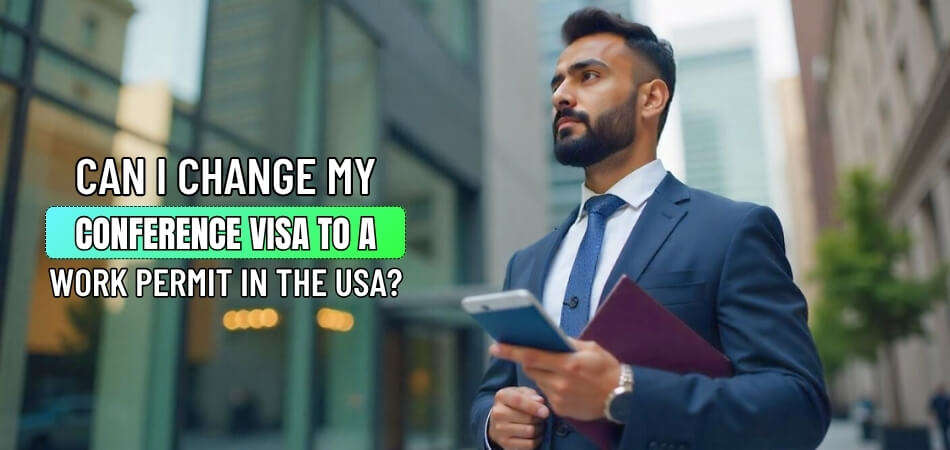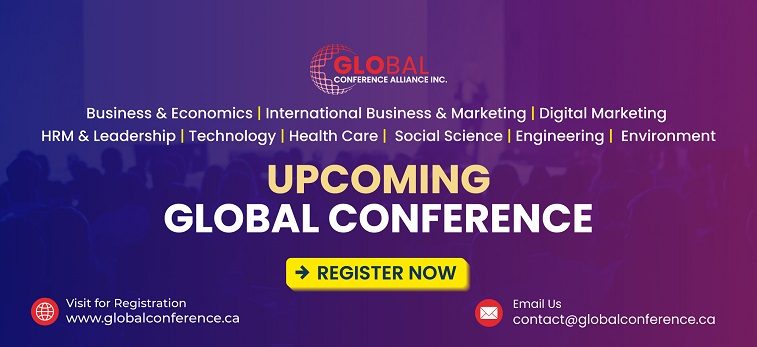Exploring the intricate pathways of visa transitions in the USA involves careful consideration and adherence to regulations. The question, can I change my conference visa to a work permit in the USA reflects a common query among individuals seeking to transition their immigration status.
The process entails a series of intricacies, often hinging on the timing of such requests. Within the initial 90 days of arriving in the country, altering one’s visa status can be perceived as a presumption of misrepresentation by the government.
Hence, individuals must proceed judiciously when seeking to change their visa status, particularly from a conference visa to a work permit. Understanding the legal implications, procedural nuances, and potential challenges becomes crucial for a successful transition while complying with immigration regulations.
What is a Conference Visa in the USA?
This type of visa offers many opportunities for professionals to attend seminars, meetings, and conferences in the USA. Conference attendees usually apply for a B-1 visa, a temporary visa for business-related activities. This visa does not permit employment but allows business consultations, negotiations, and participation in conventions. Professionals, researchers, and academics commonly use it to attend conferences.

To secure the B-1 visa, applicants need proof of their conference registration, itinerary, and ties to their home country, ensuring their return. The visa’s duration varies but doesn’t typically exceed six months, and extensions may be requested.
It’s important to apply well in advance as processing times can fluctuate. Submit your application now for the upcoming conference in USA to boost the chances of approval, one should provide detailed, consistent, and genuine documents. Beware of overstaying, as it might lead to future entry challenges.
What is a Work Permit Visa in the USA?
The USA, a hub for global talent, provides various visa options for those seeking employment. The primary work visa, H-1B, supports skilled professionals seeking employment in specialty occupations. Employers sponsor candidates; the visa duration is typically three years, extendable to six. Every year, there’s a cap, making the application competitive.
Another option, the L-1 visa, is designed for intra-company transferees moving to US branches. L-1A is for managers and executives, while L-1B caters to specialized knowledge employees. Both categories have different validity periods and requirements.
For seasonal or temporary work, the H-2B visa is appropriate. Employers need to prove the absence of US workers for the position. The visa holder can stay for the job’s approved duration.
Can I Change My Conference Visa to a Work Permit in the USA?
Initially, individuals enter the US on a B-1 visa for conferences, which has clear stipulations. This visa category prohibits employment and is strictly for business engagements, such as meetings or conferences. Therefore, the direct transition to a work visa is more complicated. First, get a US visa for a conference to apply for the visa-changing processes. Based on your conference visa status, visa officers will ask for additional documents.
However, changing visa status while in the US is possible under certain conditions. One would require an employer willing to sponsor a work visa, such as H-1B. After securing sponsorship, you’ll initiate the status change process with USCIS.
Timing is important. Your B-1 status should remain valid throughout the application process. If your B-1 visa expires before approval, you might face complications. Always consult with an immigration attorney for personalized advice.
Eligibility Requirements for Work Permit Visa in the USA
Securing a Work Permit Visa in the USA demands meeting specific criteria. Let’s find out the vital eligibility requirements.
Employer Sponsorship
Most US work visas, like the H-1B, necessitate an employer’s sponsorship. The sponsoring company files a petition with the USCIS on behalf of the foreign worker. With this sponsorship, the standard work visa process can commence.
Specialty Occupation Qualification
The H-1B visa targets specialty occupations that require specific skills or higher education degrees. The role should match the applicant’s educational qualifications or work experience. A bachelor’s degree or equivalent in a relevant field is expected.
Prevailing Wage Confirmation
Employers must ensure they pay the prevailing or actual wage, whichever is higher. This protects both US and foreign employees. The Department of Labor determines these wage levels based on occupation and region.
LCA (Labor Condition Application) Approval
Before filing the visa petition, employers must get a certified LCA. This document confirms the employer will pay the prevailing wage and offer suitable working conditions. Furthermore, the LCA guarantees no adverse effects on current employees.
Maintain Valid Status
If you’re already in the US on another visa, ensure you maintain its validity. Before your current visa expires, you must apply for a work visa. Overstaying or violating visa terms can lead to application denials or deportation.
No Criminal History
A clean record is essential for visa approval. Background checks will be conducted, and criminal history can jeopardize the application. It’s advised to be honest and transparent about any past issues.
Applying for the Change from Conference Visa to Work Permit
Changing your visa status from a Conference (B-1) to a Work Permit in the USA involves meticulous steps. There are several steps to change your visa status into a work permit. Of course, to apply for a work permit you will need a US Visa for a conference firsthand. Do you have one? Then follow the rest of the steps to complete the application process of changing a conference visa to a work permit.
Step 1: Secure a Job Offer
Before initiating any visa transition, secure a job offer from a US employer. This offer acts as the foundation for your work visa application. The employer will be responsible for sponsoring your work visa.
Step 2: Employer Files Form I-129
Your sponsoring employer must file the Petition for a Nonimmigrant Worker, Form I-129, with USCIS. This form proposes a change in your visa status. Timely filing before your B-1 visa expiration is crucial.
Step 3: Await the Decision
Once the I-129 form is submitted, you must await the USCIS decision. During this time, it’s imperative to maintain your B-1 status. Avoid any actions that could jeopardize your application, such as unauthorized employment.
Step 4: Pay Necessary Fees
If your petition advances, you and your employer may need to pay specific visa fees. These vary based on the visa type and country of origin. Always ensure payments are made promptly to avoid delays.
Step 5: Attend the Interview
Upon approval, you may need to attend an interview at a US consulate or embassy. This step is essential for visa issuance. Prepare necessary documents and respond honestly to interview questions.
Step 6: Receive Updated Visa and I-94 Forms
Post-approval and interview, you’ll receive an updated visa and I-94 form. The I-94 indicates your changed status in the USA. Ensure you keep these documents safe and accessible.
Processing Time for the Change from Conference Visa to Work Permit
Transitioning from a Conference Visa to a Work Permit in the USA involves multiple steps, each with its processing timeframe. Here’s a look at the timeline.
Job Offer Acquisition
Finding a suitable job and securing an offer might take weeks to months. Various factors like the industry, role, and expertise influence this duration. Networking and prior connections can expedite the process.
Form I-129 Filing
Once the employer is ready, they’ll submit Form I-129 to USCIS. This form’s processing can take anywhere from 2 to 6 months. Premium processing, available for some visa types, can reduce this to 15 calendar days.
USCIS Decision Time
After submission, USCIS evaluates your application for approval or denial. The complexity of your case, the time of year, and application volume impact their decision timeframe. Typically, a response is expected within those, as mentioned earlier, 2 to 6 months.
Visa Fee Payment and Scheduling
Upon I-129 approval, you’ll move to the visa fee payment stage. After payment, which is generally quick, you’ll schedule an interview. Available slots and the specific US consulate’s workload might cause slight scheduling delays.
Interview and Final Decision
The interview itself might last just a few minutes to an hour. After the interview, if approved, visa issuance can range from a few days to a couple of weeks. Delays might occur due to administrative processing or document verification.
In conclusion, while the procedural steps are standardized, the exact duration for each phase can vary. It’s essential to factor in potential delays and start the transition process well before your Conference Visa expires.
Perks of Having a Work Permit Visa in the USA?
Holding a Work Permit Visa in the USA unlocks numerous advantages. Let’s explore the advantages of having a work permit visa.
- Higher Earning Potential: US jobs often offer competitive salaries. This can lead to enhanced financial stability and savings potential.
- Cultural Exposure: Working in the US exposes individuals to diverse cultures. This cultural immersion broadens horizons and fosters personal growth.
- Professional Development: The USA houses many global corporations and industries. Employment here can fast-track one’s career and professional development.
- Education Opportunities: A work visa makes access to certain educational benefits easier. This allows for continuous learning and skill enhancement.
- Pathway to Residency: A work visa can sometimes be a stepping stone to permanent residency. This offers a path to eventual citizenship for some.
In essence, a Work Permit Visa in the USA offers professional opportunities and personal and educational growth avenues.
FAQs
Here is a list of other event questions and their respective answers given by our experts. These will help you understand the visa transformation process.
Can I Apply for a Work Visa While on a B-1/b-2 Visa?
Ans. You can apply for a work visa while in the USA on a B-1/B-2 visa, but you must typically leave the country to process the work visa. The application for the work visa must be filed by a U.S. employer who is willing to sponsor you.
Can I Change My Conference Visa (B-1/b-2) to a Work Permit in the USA?
Ans. No, you cannot directly change a B-1/B-2 visa to a work permit. To work in the USA, you need to apply for a work visa, such as an H-1B or L-1, through a U.S. employer who will sponsor you. You must leave the USA and apply for the appropriate work visa from a U.S. consulate abroad.
What Happens if I Start Working on a B-1/b-2 Visa?
Ans. Working on a B-1/B-2 visa is a violation of visa terms, which can result in deportation, a ban from re-entering the USA, and difficulties obtaining future visas. B-1/B-2 visas are strictly for business or tourism and do not authorize employment.
Can I Extend My B-1/b-2 Visa if I Am Looking for a Job?
Ans. You may request an extension of your B-1/B-2 status if you need more time for legitimate activities like additional meetings or tourism. However, using the extension period solely to search for a job is not permitted and could lead to complications with your visa status.
What Should I Do if My Change of Status Request is Denied?
Ans. If your change of status request is denied, you must cease any plans for employment and comply with your B-1/B-2 visa terms by leaving the USA before your visa expires. You may reapply for the correct work visa from outside the USA.
Final Considerations
Changing visa statuses often evokes apprehension due to intricate immigration laws. For those wondering, can I change my conference visa to a work permit in the USA? The process, while indirect, is feasible.
The B-1 Conference Visa explicitly prohibits employment, meaning one cannot directly transition to work. However, the solution lies in securing employer sponsorship. Obtaining a job offer from a US-based employer willing to sponsor a work visa opens the door to potential visa status change.
While the path from a conference visa to a work permit requires careful navigation, with the proper steps and a clear understanding, the transition is indeed attainable.







